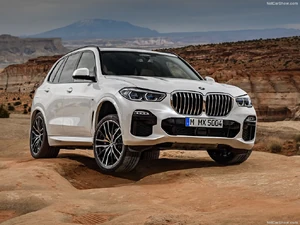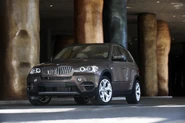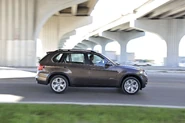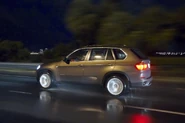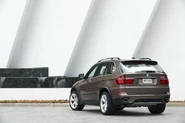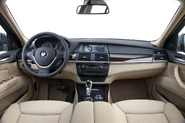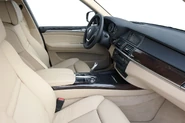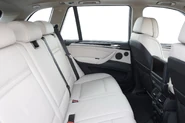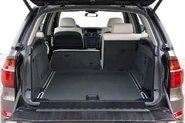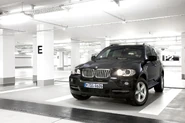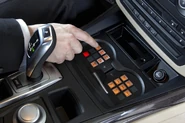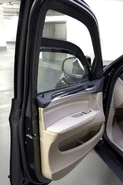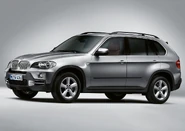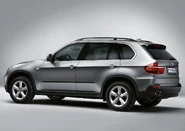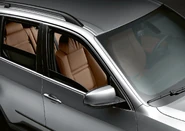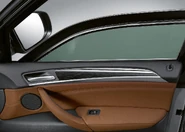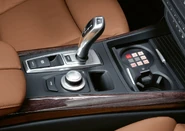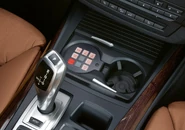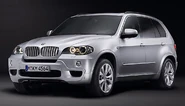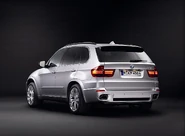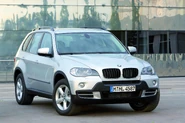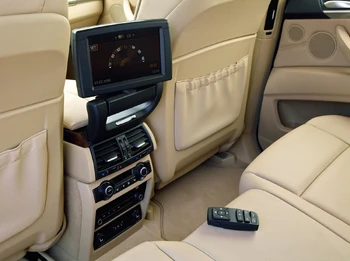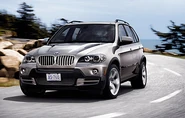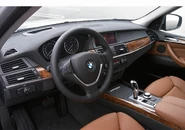The BMW X5 is a mid-sized luxury SUV produced by BMW. The X5 made its debut in 1999 as the E53 model. It was BMW's first SUV. At launch, it featured all-wheel drive and was available with either a manual or automatic gearbox. The second generation was launched in 2006, and was known internally as the E70. The E70 featured the torque-split capable xDrive all-wheel drive system mated to an automatic gearbox. In 2009, the X5 M performance variant was released as a 2010 model.
BMW marketed the X5 officially as a "Sports Activity Vehicle" (SAV), rather than an SUV, to indicate its on-road handling capability despite its large dimensions. The X5 signaled a shift away from the utilisation of body-on-frame construction, in favour of more modern monocoque chassis construction. Although the Mercedes-Benz M-Class was introduced more than a year prior to the X5, the X5 was the first to utilise a monocoque chassis. The M-Class used body-on-frame construction until its second generation.
See Autopedia's comprehensive BMW X5 Review.
Recent Changes[]
- For 2011, BMW has given its US-Spec X5 a performance package aimed at improving the SUV's aerodynamics and give the interior a sportier appearance. The package includes redesigned bumpers and side skirts, a set of black “kidney grilles”, aluminum pedals and footrest and thick-rimmed racing-inspired steering wheel hand-stitched in Alcantara.
- For 2011, BMW has given the X5 a minor facelift as well as two new gas engines: The base xDrive35i is getting BMW's new 300-horsepower N55 single-turbo 3.0-liter inline-six while the higher-end xDrive50i is now powered by their 400-horse twin-turbo 4.4-liter V8. Both engines are mated to a new 8-speed automatic and both models will feature KERS-style brake energy regeneration to reduce parasitic losses. Pricing for the xDrive35i starts at $46,675 while the xDrive50i begins at $59,275.
- A few months after the release of the X5 Security, BMW one-upped the bullet-resistant model by unveiling the BMW X5 Security Plus, which is rated with Class Six bullet resistance - the first from a high-volume manufacturer. The new car is equipped with thicker bulletproof glass and armor-plating, this means the X5 Security Plus can withstand machine gun fire such as an AK-47. Under the hood, the X5 Plus is equipped with BMW's 4.8 litre V8, developing 355 hp for 0-100kph sprints of 8.2 seconds and a governed top speed of 112 mph.
- For 2009, BMW adds a literally bulletproof model to the X5 range. The X5 Security is armored to a VR4 bulletproofing classification, meaning it is able to withstand .44 Magnum, .357 Magnum, or nine-millimeter Luger shells. To achieve this, BMW has reinforced every single body panel with a ballistic-resistant armored fiber. The windows have been replaced with laminated security glass 22-mm thick. All these upgrades obviously mean added heft so the Security package comes only with the X5's 350 hp 4.8 litre V8 and has had its suspension and brakes ripped out and replaced with beefier ones.
- The X5 was not outfitted with the new R6 engine, which increased power for both the 2.5i and 3.0i versions of the 2006 X3 and Z4 significantly. It is rumored that BMW held back deploying the engine in the 2006 X5 so as not to waste development costs (retooling the assembly line), and to make way for a much more dramatic unveiling of the all new 2007 BMW X5.
- For June 2007, BMW introduced the M Sport Package for its second-generation X5.
- The 2008 X5 sees the addition of the 3.0L twin-turbo diesel engine ( X5 3.0sd) that produces 286 Hp @ 4,400 rpm with a maximum torque figure of 580 Nm or 427 lb-ft from 1,750 rpm and BMW's EfficientDynamics across the range. Fuel economy and emission ratings are up by 4 to 7 percent compared to previous models.
Styles and Major Options[]
The BMW X5 comes in three trims: the 3.0i, 4.4i, and 4.8is. Each trim specification refers to the size of its engine, and as the engine size increases from one level to the next, more standard features are also offered. Some of the standout features are:
3.0i[]
- 3.0L 225hp Straight-6 Engine
- 17" Silver Alloy Wheels
- Driver Seat Memory
- Leatherette Interior Seats
- Automatic Air Conditioning
- Cruise Control
4.4i[]
- 4.4L 315hp V8 Engine
- 18" Silver Alloy Wheels
- Leather Seating
- Rear Air w/Separate Controls
- Front and Rear Park Distance Control
4.8is[]
- 4.8L 355hp V8 Engine
- 20" Silver Alloy Wheels
- Sport Ride
- Driver/Front Passenger Heated Seats
- Express Open/Close Sunroof
- Premium 12-Speaker Stereo w/6-CD Changer and Graphic EQ
- BMW Assist Emergency System
Pricing[]
Today's actual prices for the BMW X5 can be found at CarsDirect.
|
X5 Trims | ||
|
3.0i |
4.4i |
4.8is |
|
MSRP |
||
|
$42,500 |
$53,600 |
$71,100 |
|
Invoice |
||
|
$38,855 |
$48,955 |
$64,880 |
Gas Mileage[]
As seen on the FuelEconomy.gov website, the City/Highway MPG averages are as follows:
|
Trim | |||
|
3.0i
|
3.0i
|
4.4i
|
4.8i
|
|
MPG |
|||
|
15/21 |
16/21 |
16/22 |
16/21 |
Reliability[]
- Analysis of the X5 by Automotive Information Systems yielded positive ratings in all of its major categories. In addition, the X5 received an overall score of 77 from Consumer Reports. According to the guide, "Reliability of the six-cylinder model improved to average, allowing us to recommend it. The V8 still has below-average reliability."
- RECALL ALERT: As part of a 29,250 unit recall which includes the 550i and 650i, the MY 2007 X5 4.8i is being called back to BMW dealerships for repairs. The problem is due to an engine cable malfunction that, according to the NHTSA, in conditions of below freezing temperatures combined with low humidity, has a possibility to produce electrostatic discharge at the fuel rails which will result in the electronic control unit (ECU) to fry and the engine to stall.
Safety[]
Although it was not tested for Rollover, the X5 received the highest rating of 5/5 stars for all other NHTSA crash tests, with the exception of the Front Seat Side-Impact test, for which it received 4/5 stars. All trim levels come with the following standard safety equipment:
- DSC-X Electronic Stability Control (ESC)
- Front and Rear Anti-Roll Bars
- 4-Wheel Anti-Lock Brakes (ABS)
- Front- and Side-Impact Airbags
- Front and Rear Overhead Airbags
- Side Impact Bars
Photos[]
Colors[]
A full list of colors for the X5 is available for viewing at CarsDirect.com. Here are some of the options:
Exterior
- Alpine White
- Imola Red
- Jet Black
- LeMans Blue Metallic
- Sterling Gray Metallic
- Titanium Silver Metallic
Interior
- Black
- Sand Beige
- Truffle Brown
Main Competitors[]
- Acura MDX
- Land Rover Range Rover
- Lexus RX 330
- Cadillac SRX
- Infiniti FX35/FX45
- Audi Q7
- Lexus LX470
- Mercedes-Benz ML
- Porsche Cayenne
Hybrid Models[]
There are no hybrid models of the BMW X5.
Unique Attributes[]
Resale Values[]
According to Kelley Blue Book, the X5 should retain 67% of its retail value after 24 months and 53% of its value after 48. This sets the X5 higher than models such as the Cadillac SRX and Mercedes-Benz ML-Class, but more on par with the Volvo XC90 and Porsche Cayenne.
Criticisms[]
- "...this isn't what we'd call a highly capable off-road vehicle. And cargo capacity isn't a strong point." - New Car Test Drive
- "Four-wheel drive: Inferior to less-sophisticated, conventional systems in snow and ice." - USA Today
- "...a jarring ride on all but the smoothest blacktop..." - Car and Owner
- "If you need lots of cargo and people space, the X5 may not suit your needs. The 4.4- and 4.8-liter V8s have plenty of power, but you'll pay the price for it at the dealership and at the pump." - Kelley Blue Book
- "Next time the road ahead is closed, could you escape up the embarkment and across the fields in an X5? I think not. But in a Range Rover you could. I know. I've done it". - Top Gear
Fourth generation (G05/G18; 2019)[]
Information on the G05 X5 was released online on 6 June 2018.
The G05 X5 uses BMW's Cluster Architecture (CLAR) platform also found in the G11 7 Series and G30 5 Series. It features a five-link rear suspension and is also available with four-wheel steering or adjustable air suspension that can be raised or lowered by 40 mm (2 in). Compared to its predecessor, the G05 X5 is 36 mm (1 in) longer, 66 mm (3 in) wider, and 19 mm (1 in) shorter in height. All petrol models feature particulate filters while all diesel models feature AdBlue injection that reduces nitrogen oxide emissions.
Almost all regions feature xDrive all-wheel drive, but a rear-wheel drive sDrive model is available in the U.S. The xDrive50i model is available outside the European markets, while the European markets will get the M50i models. For the 2020 model year the M50i became available to the North American market in replacement to the xDrive50i model.
In August 2019, BMW revealed an armoured variant called X5 Protection VR6, which can withstand attacks from AK-47 bullets.
Models[]
X5 M[]
At the 2019 Los Angeles Auto Show, for the 2020 model year, BMW released the X5 M and X5 M Competition performance variants. Both models use a 4.4 L S63 twin-turbo V8. The X5 M produces 600 hp (610 PS; 450 kW) and accelerates from 0–100 km/h (0–62 mph) in 3.9 seconds, while the Competition variant produces 617 hp (626 PS; 460 kW) and accelerates to 0–100 km/h (0–62 mph) in 3.8 seconds.[20] Both models are an increase from the 567 hp (575 PS; 423 kW) produced by the previous F15 generation X5 M. In addition to the horsepower increase, major differences between the standard model and the Competition are an upgraded exhaust system, larger rear wheels and tires, Track mode, and improved standard leather upholstery.
X5 xDrive45e[]
Alongside the standard petrol variants, in 2019, BMW launched the xDrive45e plug-in hybrid variant of the X5. It was later introduced to the U.S. market in the summer of 2020. The xDrive 45e features a 24 kWh lithium-ion battery combined with a 3.0 L B58 turbo I6 and an electric motor that produces 113 hp (115 PS; 84 kW). In European models, 21.6 kWh of battery capacity was usable, while in the US that figure is only 17.06 kWh. The American model's range is 30 miles (48 km), as estimated by the EPA. The American-market car, including its batteries, are produced at BMW's plant in Spartanburg, South Carolina.
X5 long-wheelbase[]
BMW has officially launched the all-new G18 X5 xDrive30Li and xDrive40Li in China, which will be produced by the BMW Brilliance Automotive joint venture at the upgraded Shenyang Dadong plant from April 2022. According to BMW, the G18's wheelbase is 130 mm (5.1 in) longer than the regular G05. All of the extra length goes to enhance the rear passenger legroom and seating comfort. This is also reflected in the longer rear doors, which now provide easier access to the second row of seats, but otherwise, the X5 LWB (long wheelbase) retains many cues from the standard wheelbase model.
Third generation (F15/F85; 2014)[]
Production models[]
BMW X5 M50d, BMW Individual range, Original BMW Accessories (2013-)[]
The BMW X5 M50d includes Adaptive M suspension (Dynamic Damper Control and air suspension at the rear axle, Electric Power Steering) and 19-inch M light-alloy wheels in double-spoke design, mixed tyres. The optional Dynamic adaptive suspension package includes Dynamic Performance Control and Dynamic Drive active roll stabilisation.
The BMW Individual range includes additional customisation options, such as up to seven layers of paint (including Ruby Black metallic and Pyrite Brown metallic) and the addition of special colour pigments creating iridescent effects, 20-inch BMW Individual light-alloy wheels in V-spoke design with mixed tyres, fine-grain full Merino leather trim in Amaro Brown and Criollo Brown from BMW Individual and BMW Individual interior trim strips in Piano Finish Black or Sen Light Brown.
Original BMW Accessories range for the BMW X5 include floor mats (with rubber surface integrated in the foot area), luggage compartment mats, transport bags (includes a Storage Bag Fond), seat organiser, ski and snowboard bag (max 4 pairs of skis or 3 snowboards, integrated rollers, handles and a shoulder strap) and transport bag for ski boots, helmets and gloves.
The BMW Individual range was scheduled to be available from December 2013.
X5 M[]
The BMW M performance derivative of the F15 X5 is designated F85 and was released in 2015. Its S63B44T2 4.4-liter V8 engine has 423 kW (567 hp) and 553 lb⋅ft (750 N⋅m) of torque, making it the most powerful engine ever developed for an all-wheel drive BMW at the time. The engine has M TwinPower Turbo and Valvetronic technologies, to deliver a 0–100 km/h (62 mph) time of 4.2 seconds.
An M-tuned xDrive all-wheel drive system provides traction. It distributes drive between the front and rear axles, while Dynamic Performance Control distributes torque between the 21-inch M Double-spoke light-alloy wheels.
X5 xDrive40e[]
The BMW X5 xDrive40e is the first plug-in hybrid released under the core BMW brand. The use of BMW's eDrive technology on the established X5 platform is a direct technology transfer from the BMW i cars, in particular, from the BMW i8 technology.
The X5 xDrive40e features a 2.0 L turbocharged gasoline engine 180 kW (241 hp) coupled to a 83 kW (111 hp) electric motor and a 9.0 kWh battery.
The production of the plug-in hybrid variant was scheduled to begin in April 2015. Retail deliveries (US) began in October of 2015. Pricing started at US$62,100 (equivalent to £40,365) before applicable US government incentives.
The US EPA rated the X5 xDrive40e combined city/highway fuel economy at 68 mpg‑US (3.5 L/100 km; 82 mpg‑imp) equivalent (MPG-e) in all-electric mode (energy consumption of 59 kW-hrs/100 mi). The fuel economy in gasoline-only mode was rated at 24 mpg‑US (9.8 L/100 km; 29 mpg‑imp). EPA's all-electric range is 14 mi (23 km) with the car using some gasoline, and as a result, EPA's official range varies between 0 and 14 mi (0 and 23 km).
Specifications[]
Design[]
The new generation BMW X5 is 5 mm (0.2 in) wider, 26 mm (1.0 in) longer and 14 mm (0.6 in) lower than E70, but wheelbase remains at 2,933 mm (115.5 in). At the front F15 takes design from F30 3 Series while at the back it's similar to other current X series models. The interior now features 10.25 inch display. The exterior, designed by BMW designer Mark Johnson, was approved in November 2010 and production finalised in 2011.
Technology[]
BMW claims the new X5 is made of ultra-high-tensile steel in the body structure, thermoplastics in the side panels, aluminium in the bonnet and magnesium in the instrument panel support to make the new BMW X5 lighter. Depending on the model, the new X5 is as much as 90 kg (198 lb) lighter than a comparably equipped corresponding model from the previous X5 generation.
Second generation (E70; 2006)[]
The E70 BMW X5 was 60 mm (2.4 in) wider, 165 mm (6.5 in) longer; with a 110 mm (4.3 in) longer wheelbase, but remains at the height of the E53 X5 at 1,766 mm (69.5 in).
Technology[]
The xDrive AWD system updates previewed in the facelifted X5 have continued with further detail improvements for the E70. It uses a double wishbone suspension at the front. The manual transmission is entirely dropped, leaving only the automatic transmission.
The E70 features many new technological advancements for this class as standard equipment including BMW's iDrive system, electronic 'joystick' gearshift (no mechanical connection to the gearbox to save space in the console), LED taillamps, the first ever all-polypropylene single module fender module, and options such as heads-up display (HUD), active steering, active damping, and Dynamic Drive which uses active anti-roll bars employing a hydraulic servo in the middle to actively counteract body roll. The X5 has a rollover risk of 17.4%.
The interior of the X5 is completely new. It has a large center-mounted display screen and the simplified iDrive, a man-machine interface system also found in the rest of the BMW model range. The E70 further incorporates many comfort options such as a glass panorama-roof, and, for the first time in a BMW, an optional third row seat which has increased the seating capacity in E70 to 7 passengers, addressing criticism of the E53 model which had been regarded as being slightly too small for this market segment.
The E70 is also the first production vehicle to use FlexRay, a new extremely fast electrical bus system; it is only used for the control of the chassis damping system. The new 'joy-stick'-style electronic space-saving shifter has since been adopted in the new 2008 BMW 5 Series.
BMW X5 M (2009-14)[]
The BMW X5 M is a high-performance derivative of the X5. It was introduced to the press at the New York Auto Show in April 2009 and started appearing in BMW dealerships in September 2009. It competes with cars such as the Mercedes-Benz ML63 AMG, the Porsche Cayenne Turbo S, and the Jeep Grand Cherokee SRT8. At the time of its launch, it was the most powerful car in its class.
The BMW X5 M is the first xDrive all-wheel-drive vehicle from M GmbH along with the X6 M. The M offers the same utility as the regular X5, with the addition of the V8 M TwinPower Turbo, a twin-turbocharged 4.4-liter V8 delivering 547 bhp (408 kW; 555 PS) at 5,750 rpm and peak torque of 501.2 lb⋅ft (680 N⋅m), available between 1,500 and 5,650 rpm. The S63 engine is a high output variation of the N63 power unit.
The X5 M can sprint from a standstill to 60 mph (97 km/h) in 4.0 seconds, and a quarter-mile (402 m) time of 12.2 seconds with a trap speed of 115 mph (185.1 km/h) was recorded by Car and Driver magazine. In the same test, the X5 M bested the 0–60 mph (97 km/h) and quarter-mile times of the 2009 Porsche Cayenne Turbo S, the 2009 Jeep Grand Cherokee SRT-8, and the 2010 Range Rover Sport Supercharged. In wet conditions, the X5 M went around the Top Gear Test Track in 1:28.2, 5.1 seconds faster than the Audi Q7 V12 TDI.
Coupled with special suspension specifically optimized for M that features Adaptive Drive and the newly developed M Servotronic power steering, the performance Sport Activity Vehicle promises very competent handling. Other high-tech features include launch control for maximum acceleration and a six-speed M Sport automatic transmission optimized for performance. Drivers can manually select gears using either paddles or an electronic gear selector lever. Electronically controlled, variable power distribution to the front and rear axle prevents the tendency to oversteer or understeer, before DSC Dynamic Stability Control is required to cut in.
The BMW X5 M features the biggest brakes on a BMW production vehicle, with 15.55" (395x36mm) rotors up front clamped by four-piston calipers, and 15.2" (385x24mm) rotors at the rear with single-piston calipers. Although traction control is standard, the M Dynamic Mode (MDM) reduces the effect of the system, allowing some wheelspin and drift-type cornering.
For the 2013 model lineup, BMW introduced the M Performance Package available for the xDrive35i and xDrive50i. The M Performance Package models have nearly identical features to the X5 M (sport suspension, wider fenders, staggered wheels, etc.) excluding the quad-tip exhaust, headlights, and engines. The M Performance Package also bumped up the engine output for both models - an additional 15 hp (11 kW) for the xDrive35i and 40 hp (30 kW) for the xDrive50i (torque was also increased by 30 lb-ft for both).
2010/2011 X5 "Life Cycle Impulse" (LCI) Changes[]
In 2010 the X5 underwent a "Life Cycle Impulse" (LCI) update, debuted at the New York Auto Show in April 2010 and introduced as 2011 models in BMW North America markets. The changes included revised styling, primarily of the front and rear bumpers, air intakes, headlights, and taillights as well as new exterior and interior colors and new options combination. It also included BMW Group's latest infotainment system. HD Radio, previously an option, was now standard on all X5 models in North America.
More significantly, a new range of engines, all turbocharged and with direct injection was introduced. In the North American market, available gasoline power trains are the xDrive 35i twin-scroll turbo six-cylinder and the xDrive50i twin turbo V8, both coupled to an eight-speed automatic Steptronic transmission. These petrol engines are more powerful than their predecessors, with the 35i also providing improved fuel mileage and reduced emissions. The xDrive 35d turbodiesel carries over in the NA market with the six-speed transmission unchanged from the previous model year. The xDrive40d was also introduced along with a revised xDrive30d, but neither was available in the North American market.
The X5M engine and transmission remains the same.
First generation (E53; 1999)[]
The E53 X5 was developed just after the acquisition of Land Rover by BMW. As such, the vehicle shares many components and designs with both the Range Rover L322 model (specifically the hill descent system and off-road engine management system) and the BMW E39 5 Series (specifically engines and electronic systems). The entire in-car entertainment system (radio function, navigation system, television and telecommunications systems) are shared with other BMWs and L322. As a result, the earlier X5 models can be upgraded with newer BMW technologies (e.g. Bluetooth phone connectivity).
The history of the X5 begins in 1994, when ideas began on a BMW sports utility vehicle after the acquisition of Land Rover. Eduard Walek was named project leader and chief engineer of the E53. Chris Chapman joined BMW Group's Designworks in California later and began working with Chris Bangle in Munich on two full-scale clay models of the E53 for two months. By 1996, design work was approved and the design basis for the X5 (E53) was frozen, 35 months prior to production. Design patents were filed on 10 June 1998 and 9 December 1998, being registered in the U.S. on 18 January 2000.
The takeover of Rover in 1994 was proved to be very beneficial for BMW in the development of the X5. BMW engineers were able to look at and use Range Rover technology and parts in the development of the X5 - one such example would be hill-descent control. In many respects, the design of the X5 was influenced by its British counterpart; for example, the X5 got the two-piece tailgate straight from the Range Rover. Many parts and electronics were also taken directly from the E39 5 Series parts bin to save costs.
In contrast to the Range Rover models, the X5 was designed as a sporting road car: its off-road capabilities are significantly less than those of Land Rover. BMW reportedly worked hard to ensure it was referred to as an SAV (Sports Activity Vehicle) instead of an SUV (sport utility vehicle).
Even though the X5 was an all-wheel drive vehicle, BMW chose from the start to route 62 percent of the engine's torque to the rear wheels, making it feel as close as possible to the company's rear-wheel drive sedans.
2003 facelift[]
In 2000, development on mid-cycle updates began scheduled for 2003. By late 2001, a radical design update was chosen favoring the new brand design theme. In 2002, following discontent towards the 2001 E65 design, a more conservative appearance was instead chosen and frozen for 2003 production.
In July 2003, the facelifted X5 was presented for the 2004 model year at the IAA 2003 in September, with new headlights, a few new exterior colors, a new four-wheel drive system and upgraded engines. Production started at Spartanburg on 26 September. The grilles were enlarged, as well as their actual slats being modified in a 'flame surfaced' style. In keeping with the E39 facelift of 2001, the 2004 X5's headlights got corona rings around all four headlamp projectors. The tail-lights also received a facelift similar to the BMW E39, and the exterior glass went from a "dotted" pattern to a cleaner "line" pattern. BMW invented a new four-wheel drive system dubbed xDrive shared both in the X5 and X3 in 2004. Instead of using the previous X5 system which consisted of power being split 62-38 (rear wheels-front wheels) and DSC to brake wheels without losing traction, xDrive could vary power to the front or rear axles in milliseconds, transferring up to 100% of engine power to either axle, thus allowing the vehicle to regain traction quickly.
Several new extras were added to the 2004 X5 such as:
- Soft-boot close feature (the top part of the trunk pulls itself closed)
- Trailer Stability Program (making it an ideal tow vehicle)
- Adaptive Headlights (available only with xenon HID headlamps; these swivel with the direction of travel of the car. Bi-Xenon headlights for both low and high beam replaced the low beam HID headlights)
Originally announced in the end of 2003 along with the rest of the X5 facelift, the X5 4.8is first started shipping in April 2004. It had a new larger 4.8 L engine (which replaced the 4.6 L engine), and was also later used in the 2005 750i/Li. It also included a slightly modified bodykit (parts of the bottom bumper became painted the body color), 20" wheels, and along with the 4.6is, were the only X5's ever to have a large chrome-tipped exhaust which hid the quad pipes.
- closed)
- Control
- car)
200[]
Origins[]
The history of the X5 begins in the late 1990s, when Chris Bangle drew the first sketches from his Designworks studio in California. In many ways, the current car closely resembles these initial sketches. Bangle is both admired and derided for his unconventional and challenging designs-something both the X5 sketches and the E46 3 series can attest to. He claimed the BMW X5 was a very capable SAV.
The takeover of Rover proved to be very beneficial for BMW in the development of the X5. BMW engineers were able to look and use Range Rover technology and parts in the development of the X5-one such example would be hill descent control. In many respects the X5 was also influenced designwise by its British counterpart; in this case the X5 got the two-piece tailgate straight from the Range Rover. Many parts and electronics were also taken directly from the E39 5 series parts bin to save costs.
In contrast to the Range Rover models, however, the X5 was designed as a sporting car. BMW reportedly worked hard to ensure it was referred to as an SAV (Sports Activity Vehicle) instead of an SUV (Sports Utility Vehicle).
Even though the X5 was a four wheel drive vehicle, BMW chose from the start to route 60% of the engine's torque to the rear wheels, making it feel as close as possible to the company's rear-wheel drive sedans. Many reviewers commented on its road and track "feeling", and as time passed many other manufactures have caught onto this breed of SUV (e.g. Porsche Cayenne).
The X5 has been criticized for having low interior volume for its size - both the smaller BMW X3 and the 5 Series (Touring) have greater interior volume. The next generation X5 is rumored to rectify this problem.
The X5, along with the BMW Z4 roadster, are currently manufactured exclusively in BMW's South Carolina plant in Spartanburg.
Future Generations[]
The BMW E70 automobile platform will be the basis for the future X5 SUV. It will replace the BMW E53. It is expected that it will be released some time during 2007, and will be considerably bigger than the current E53 model and is rumoured to accommodate two extra passengers. The increase in size is due to the uncomfortably close sizes of the current generation X5 and smaller X3 model.
The next generation BMW X5 will be 60mm wider, 165mm longer; with a 110mm longer wheelbase, but will remain at the height of the current generation X5 at 1715mm. The SUV will be manufactured alongside with the new 2008 BMW X6 at BMW's South Carolina plant in the USA.
Several sources have indicated that the dashboard will be completely revised to incorporate all of the latest technical gadgets, which will be included in the next generation. These include radar-governed cruise control and night-vision. The E70 will bring new engines to the X5 lineup. BMW will begin a shift of replacing engines from the 2006 7-Series. It is likely that the E70 will inherit those same powertrains.
Transmission choices will likely remain like those today: 6-speed manual and 6-speed Steptronic. It is possible for BMW to implement their 6-speed SMG system into the V8-powered models. Also, this generation's xDrive AWD system will continue largely unchanged into the E70. Rumors also floating around is that the BMW 7-Series Electronic Shifter will be used in the E70 to rival the 2006 Mercedes-Benz M-Class' shifter.
The X5 will also be the first production vehicle to use FlexRay, a new electrical bus system; it is only used for the pneumatic damping system.
Worldwide[]
In Australia, two thirds of the whole X5 range are diesels (3.0d and 4.4d). The only petrol version available is the V8 version.
The UK police uses the X5 xDrive30d and xDrive40d as Interceptors as part of a four-year deal beginning late 2010. Other cars in the docket include the 530d Saloon and Touring, 330d Saloon and Touring, all variants of X1 and the X3 xDrive20d.
Design quirks and oddities[]
A BMW X5 was used as a support vehicle for a feature documentary Race To Dakar when Charley Boorman participated in the 2006 Dakar Rally. However, the car had suffered a few reliability problems.
A BMW X5 3.0d can travel 1100 kilometres on a single tank.
Awards[]
- Winner Australia's Best Luxury Four Wheel Drive in 2001.
- Winner Australia's Best Luxury Four Wheel Drive in 2002.
- Winner Australia's Best Luxury Four Wheel Drive in 2007.
- Winner Drive Best SUV Over $40K in 2010 (Nominee)
See also[]
External links[]
News & References
- BMW introduces bullet-proof E70 X5 ‘Security’ edition
- BMW X5 Security Edition: Heavy Armor For The BMW WIth The Big Butt
- BMW announces 335d and X5 xDrive35d pricing
- BMW X5 xDrive35d AdvancedDiesel To Challenge Audi Diesel Dominance
- BMW X5 Review from Edmunds.com
- BMW launches AK-47 thwarting X5 Security Plus
- 2011 BMW X5 SUV Officially Unveiled, gets New Turbo Engines and Subtle Cosmetic Tweaks
- Officially Official: 2011 BMW X5 goes all turbo
- Video: 2011 BMW X5 blasting around in the snow, starting at $46,675
- BMW Announces Performance Accessories for the U.S.-spec X5 Series
Enthusiast Sites ans Online Forums
- BimmerPortal The enthusiast's choice for everything BMW.
- BimmerSpace BMW Community & Owner's Garages.
- United Bimmer - A BMW community offering tech support forums, a DIY (Do It Yourself) knowledge base, and other resources for BMW enthusiasts.
- X5World is an X5 and X3 community where current and potential BMW X5 owners can learn more about the Ultimate Sports Activity Vehicle. This site also serves as an information warehouse for modifications that BMW X5 enthusiasts have made to their vehicles.

|
This page uses some content from Wikipedia. The original article was at BMW X5. The list of authors can be seen in the page history. As with Autopedia, the text of Wikipedia is available under the GNU Free Documentation License. |
